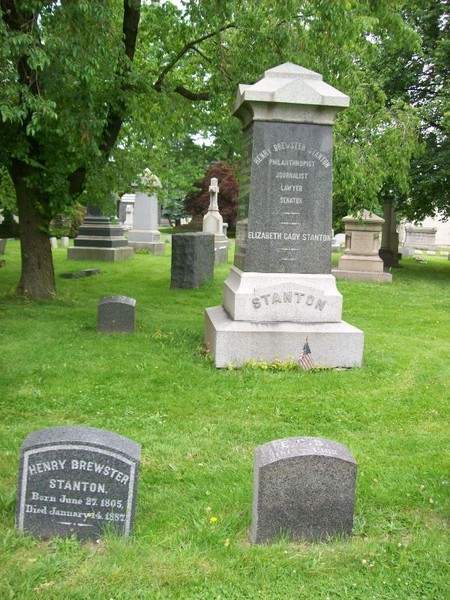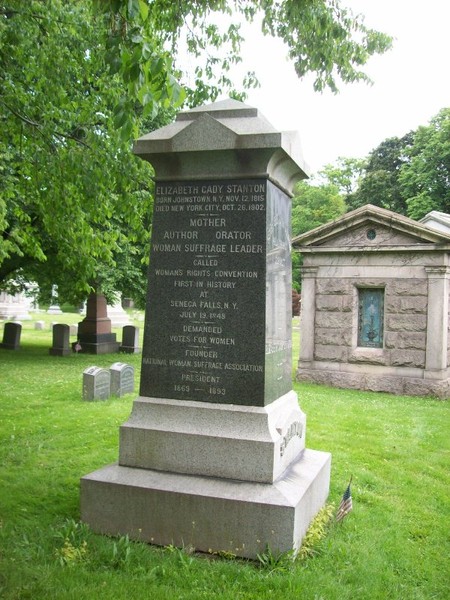Elizabeth Cady Stanton Gravesite
Introduction
Text-to-speech Audio
Elizabeth Cady Stanton (1815-1902) was a leader of the Women's Rights Movement. Stanton and fellow abolitionists organized the Seneca Falls Convention, considered the beginning of the women's suffrage movement. Elizabeth Stanton and Susan B. Anthony worked together to advance suffrage and many other women's issues from the 1840s into the early 1900s. Stanton was a founder of the National Woman Suffrage Association and also served as president of the National American Woman Suffrage Association.
Images
Stanton monument and family plot

Elizabeth Cady Stanton monument

Stanton and two of her sons, Daniel and Henry, in 1848

Elizabeth Cady Stanton with daughter Harriet, 1856
.jpg)
Elizabeth Cady Stanton, c. 1880
.jpg)
Universal suffrage petition to Congress, Stanton and Anthony are the first two signatures
.jpg)
Elizabeth Cady Stanton and Susan B. Anthony, c. 1890
.jpg)
Backstory and Context
Text-to-speech Audio
Elizabeth Cady Stanton was born on November 12, 1815 in Johnstown, New York. She grew up listening to her father discuss law and was educated at the Johnstown Academy and Emma Willard’s Troy Female Seminary. She became involved in the abolitionist movement after marrying Henry Stanton in 1840; Stanton was an agent for the American Anti-Slavery Society and often traveled to speak about abolition. The couple’s honeymoon was to London for the World’s Anti-Slavery convention and this event is where Elizabeth Stanton met Lucretia Mott.
Stanton and Mott were both dedicated abolitionists but agreed that women were being excluded from parts of the movement and decided to organize a convention about women’s rights. They organized the Woman’s Rights Convention at Seneca Falls, NY in 1848, now considered the beginning of the women’s suffrage movement that would continue for more than seven decades. Stanton’s “The Declaration of Sentiments” is a founding document of the women’s movement, written based on the United States Declaration of Independence to call attention to the inequality in American society.
Stanton, Mott, and other anti-slavery reformers organized yearly women’s rights conventions, wrote about both women’s rights and abolition, and began to petition state and national legislatures about women’s issues. In addition to the vote, reformers spoke about marital rights, parental rights, legal rights, property rights, temperance, and other issues relating to women. Stanton met Susan B. Anthony in 1851 and the two women became the powerhouse team behind the suffrage movement (while both also working in the abolitionist movement). During the years that Elizabeth Stanton needed to raise her seven children, Anthony was often a present visitor at their Seneca Falls home, helping with the Stanton children while writing and strategizing with Elizabeth. Stanton often wrote speeches that Anthony then traveled around the country delivering.
During the Civil War the Stantons moved to the New York City area. They both worked in war efforts and Elizabeth supported the end of the abolitionist movement (the 13th Amendment) through the Women’s Loyal National League. With the completion of abolition at the end of the Civil War, Stanton’s focus turned back to the women’s rights movement. Suffragists formed the American Equal Rights Association to advocate for universal suffrage, extending the vote to both African Americans and women in the aftermath of the war. Anthony and Stanton were disappointed with the 14th and 15th Amendments, which both excluded women, and formed the National Woman Suffrage Association (NWSA) in 1869. Other suffragists were more accepting of the Reconstruction Amendments as positive steps in the right direction, causing a rift among female reformers that lasted until the 1890s.
During the 1870s Stanton actively traveled to speak about women’s suffrage and the NWSA pushed for a federal amendment to protect voting rights in the U.S. Constitution. This amendment was introduced for the first time in 1878 (often called the Susan B. Anthony Amendment) and it would ultimately become the 19th Amendment in 1920, after both Stanton and Anthony had died. Stanton started to slow down in the 1880s with less traveling, but she did agree to serve as the president of the unified National American Woman Suffrage Association in 1890. Stanton advocated for women’s rights until her death in October 1902. Stanton and Anthony wrote a three-volume documentation of the movement, along with Matilda Joslyn Gage, titled History of Woman Suffrage (1881-85) and Stanton wrote an autobiography titled Eighty Years and More.
Sources
“Elizabeth Cady Stanton (1815-1902).” Women’s Rights National Historical Park. National Park Service. May 9, 2018. Accessed July 1, 2021. https://www.nps.gov/wori/learn/historyculture/elizabeth-cady-stanton.htm.
Michals, Debra, ed. “Elizabeth Cady Stanton (1815-1902).” National Women’s History Museum. Accessed July 1, 2021. https://www.womenshistory.org/education-resources/biographies/elizabeth-cady-stanton?gclid=CjwKCAjwz_WGBhA1EiwAUAxIcXVw9lPERpaXNMxQC22cp6mc_hjlSf7ZIKI94MhoehD7r04XUSho9xoCcx4QAvD_BwE.
"Elizabeth Cady Stanton." Find A Grave. Accessed July 1, 2021. https://www.findagrave.com/memorial/974/elizabeth-cady-stanton.
"Elizabeth Cady Stanton." Find A Grave. Accessed July 1, 2021. https://www.findagrave.com/memorial/974/elizabeth-cady-stanton.
"Elizabeth Cady Stanton's Life in Seneca Falls." Women's Rights National Historical Park. Accessed July 2, 2021. https://www.nps.gov/wori/learn/historyculture/upload/site%20bulletin%20ECSH%20final.pdf.
"Elizabeth Cady Stanton." Wikipedia. Accessed July 2, 2021. https://en.wikipedia.org/wiki/Elizabeth_Cady_Stanton.
"Elizabeth Cady Stanton." Wikipedia. Accessed July 1, 2021. https://en.wikipedia.org/wiki/Elizabeth_Cady_Stanton.
"Elizabeth Cady Stanton." Wikipedia. Accessed July 2, 2021. https://en.wikipedia.org/wiki/Elizabeth_Cady_Stanton.
"Elizabeth Cady Stanton." Wikipedia. Accessed July 2, 2021. https://en.wikipedia.org/wiki/Elizabeth_Cady_Stanton.
